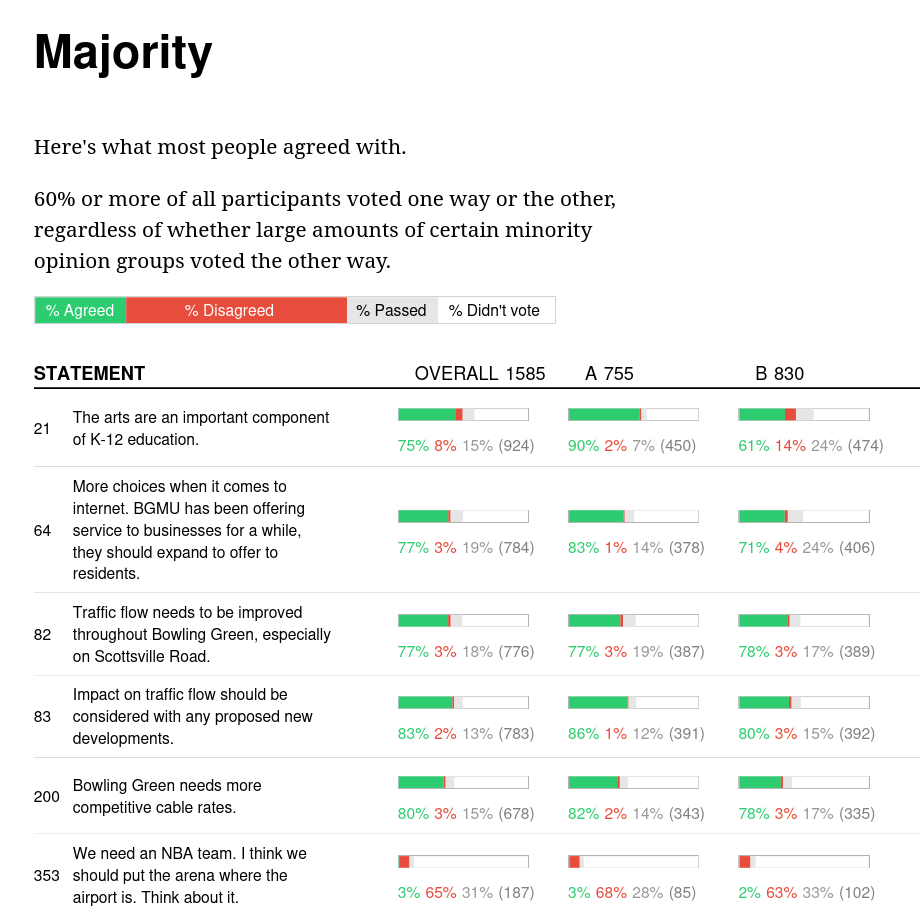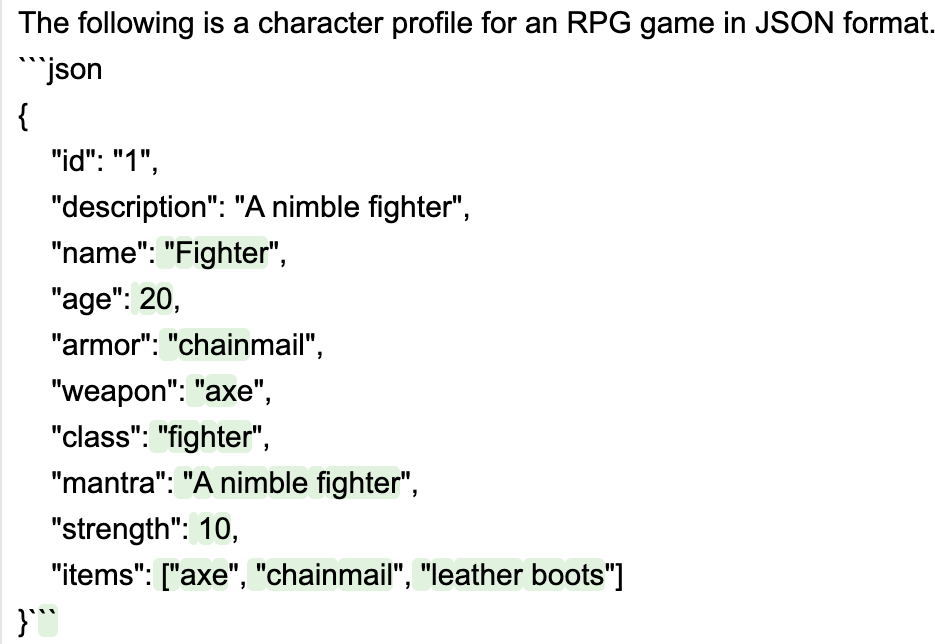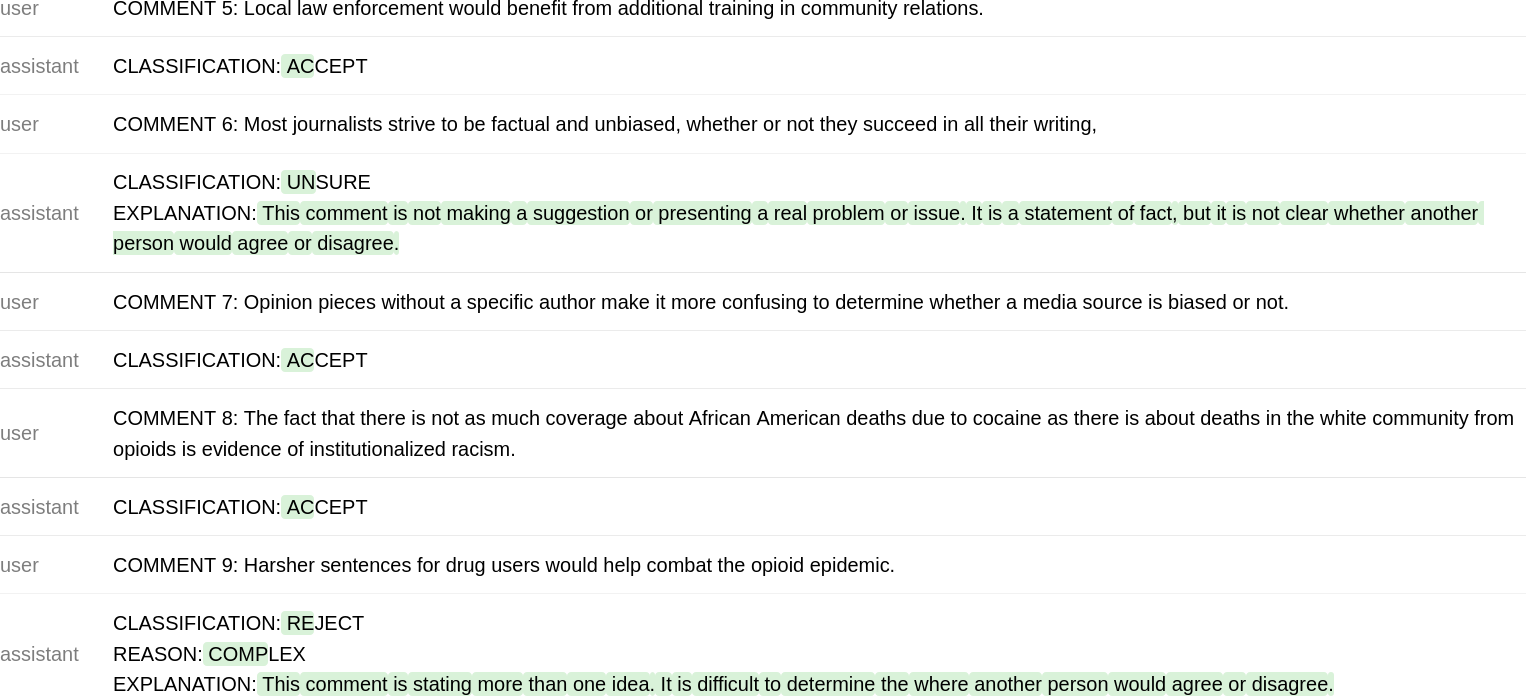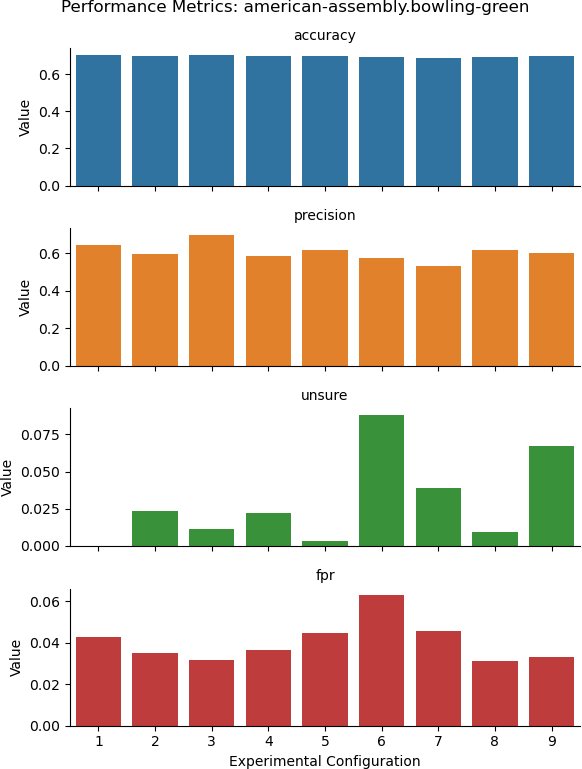Moderating Democratic Discourse
with Large Language Models
Aaditya (Sonny) Bhatia
United States Military Academy, West Point, NY
Advisor: Dr. Gita Sukthankar
University of Central Florida, Orlando, FL
Wednesday, September 18, 2024
Introduction
- Democracy ➜ policy decisions ➜ discourse
- Policy decisions are wicked problems 1 that require discourse!
- Effectiveness determined by solving it; single attempt
- Measuring impact will shift problem
- Wisdom of the crowd helps generate and evaluate solutions!
- Online deliberation works well in small groups
- Does not scale easily
- Requires human facilitation
Problem Statement
- Silos are comfortable ➜ echo chamber effect
- Lack of diversity ➜ polarization ➜ misinformation
- Misinformation shapes opinion before correction
- Facilitation complexity does not scale linearly
How do we use LLMs to improve comment moderation to allow public deliberation at scale?
Background
Polis
- “Real-time system for gathering, analyzing and understanding” public opinion
- Developed as an open source platform for public discourse
- Published several case studies
- Participants post short messages and vote on others
- Polis algorithm ensures exposure to diverse opinions
- \(\vec{comments} \times \vec{votes} =\) opinion matrix
- fed into statistical models
- understand where people agree or disagree

Human Moderation in Polis
- Near-real-time feedback (agree, disagree, neutral)
- Loosely follow Polis moderation guidelines
- Spam: devoid of relevance to the discussion.
- Duplicative: restating a previously made point.
- Complex: articulating multiple ideas or problems.
- Each organization has its own methodology
- Process is time consuming and inconsistent
Large Language Models
- Extremely good at pattern recognition and summarization
- Generate appealing content
- Reasoning for small tasks
- Use for simple decision-making
Research Questions
- How effective are LLMs for content moderation on Polis?
- How do various prompting strategies perform against human moderation?
- Can LLMs effectively augment or entirely replace human moderators?
Methodology
Data
- Summary Statistics: conversation topic, number of participants, total comments, total votes
- Comments: author, comment text, moderated, agree votes, disagree votes
- Votes: voter ID, comment ID, timestamp, vote
- Participant-Vote Matrix: participant ID, group ID, n-votes, n-agree, n-disagree, comment ID…
- Stats History: votes, comments, visitors, voters, commenters
| Dataset | Participants | Comments | Accepted |
|---|---|---|---|
| american-assembly.bowling-green | 2031 | 896 | 607 |
| scoop-hivemind.biodiversity | 536 | 314 | 154 |
| scoop-hivemind.taxes | 334 | 148 | 91 |
| scoop-hivemind.affordable-housing | 381 | 165 | 119 |
| scoop-hivemind.freshwater | 117 | 80 | 51 |
| scoop-hivemind.ubi | 234 | 78 | 71 |
Text Generation
- Guidance
- Python framework from Microsoft Research
- Precisely control generation
- Interleave control and generation seamlessly
- Models Considered

Experimental Configurations
| Config | Target Classes | Examples | Deconstruction | CoT Technique |
|---|---|---|---|---|
| 1 | 3 | No | No | N/A |
| 2 | 3 | Yes | No | N/A |
| 3 | 3 | No | No | Thought after rejection |
| 4 | 3 | Yes | No | Thought after rejection |
| 5 | 7 | No | No | N/A |
| 6 | 7 | No | No | Thought before decision |
| 7 | 7 | No | Yes | Thought before decision |
| 8 | 7 | No | Yes | N/A |
| 9 | 3 | No | Yes | Thought before decision |
Instructions: Three-Class Classification
Discussion Title: Improving Bowling Green / Warren County
Discussion Question: What do you believe should change in Bowling Green/Warren County in order to make it a better place to live, work and spend time?
---
You will be presented with comments posted on Polis discussion platform.
Classify each comment objectively based on whether it meets the given guidelines.
---
Classifications:
- ACCEPT: Comment is coherent, makes a suggestion, or presents a real problem or issue.
- UNSURE: Unclear whether the comment meets the guidelines for ACCEPT.
- REJECT: Comment should definitely be rejected for one of the reasons listed below.
---
Reasons for REJECT:
- SPAM: Comments which are spam and add nothing to the discussion.
- COMPLEX: Comments which state more than one idea. It is difficult to determine the where another person would agree or disagree.
---
Output format:
CLASSIFICATION: One of the following based on given guidelines: ACCEPT, UNSURE, REJECT.
THOUGHT: Express the reasoning for REJECT classification.
Am I certain: Answer with YES or NO. If unsure, state NO.
REASON: One of the following based on given guidelines: SPAM, COMPLEX
EXPLANATION: Provide an explanation for why the comment was classified as REJECT.Output: Three-Class Classification

Use of Examples

Second-Thought Technique

- False Positives cause more harm
- Allow the model to turn a REJECT into UNSURE
Instructions: Seven-Class Classification
Discussion Title: Improving Bowling Green / Warren County
Discussion Question: What do you believe should change in Bowling Green/Warren County in order to make it a better place to live, work and spend time?
---
Classify each comment objectively based on the following guidelines:
- ACCEPT: mentions a real problem related to the discussion.
- ACCEPT: recommends a realistic and actionable solution related to the discussion.
- ACCEPT: makes a sincere suggestion related to the discussion.
- IRRELEVANT: frivolous, irrelevant, unrelated to the discussion.
- IRRELEVANT: does not contribute to the discussion in a meaningful way.
- SPAM: incoherent or lacks seriousness.
- SPAM: provides neither a problem nor a solution.
- UNPROFESSIONAL: the language is informal, colloquial, disrespectful or distasteful.
- SCOPE: cannot be addressed within the scope of original question.
- COMPLEX: introduces multiple ideas, even if they are related to the discussion.
- COMPLEX: discusses distinct problems, making it difficult to determine where another person would agree or disagree.
- UNSURE: may be accepted if it appears somewhat related to the discussion.
---
Output format:
CLASSIFICATION: One of the following based on given guidelines: ACCEPT, UNSURE, SPAM, IRRELEVANT, UNPROFESSIONAL, SCOPE, COMPLEX.
EXPLANATION: Provide an explanation for the classification.Instructions: Comment Deconstruction
Output format:
PROBLEM: The specific problem mentioned in the comment. If only an action is suggested and no problem is explicitly mentioned, state None.
ACTION: What suggestion or change is proposed. If only a problem is mentioned and no action is suggested, state None.
HOW MANY IDEAS: Number of distinct ideas introduced in the comment.
THOUGHT: Deliberate about how the comment should be classified.
CLASSIFICATION: ACCEPT, UNSURE, SPAM, COMPLEX.
REASON: If comment was not classified as ACCEPT, explain.Output: Comment Deconstruction and Thought Statements

Results
Comment Moderation
- Accuracy generally the same
- Unsure rate increases with complexity of task
- Deconstruction reduces false positive rate
- CoT not as effective as deconstruction
- Examples must be specific to dataset
Configurations
- 1: Baseline
- 2: Examples
- 3: Thought
- 4: Thought + Examples
- 5: 7-class Baseline
- 6: Thought
- 7: Thought + Deconstruction
- 8: Deconstruction
- 9: Deconstruction, 3-class


Conclusion
LLMs in structuring online debates
- Potential of LLMs for simple tasks
- Risk of hallucinations and incorrect output
- Chaining simple tasks for complex reasoning
- Augmenting vs replacing human moderation processes
- LLMs’ limitations in processing complex instructions and sentences
- Complex instructions
- Relationship modeling based on double and triple negatives
- Reliability and bias
- Critical need for ethical and inclusive technology deployment
Future Research Directions
- Semantic extraction and reasoning during discourse
- Exploring connections across topics
- Individual feedback before posting a comment
- Generalizing techniques to platforms like Kialo, Hacker News
Comment Moderation